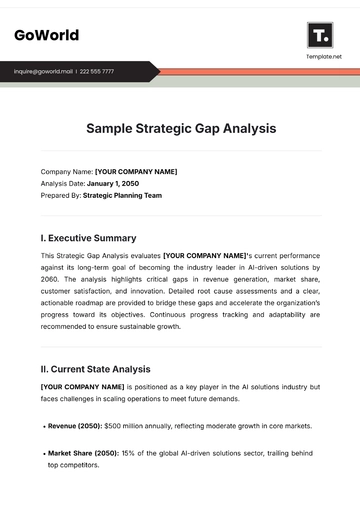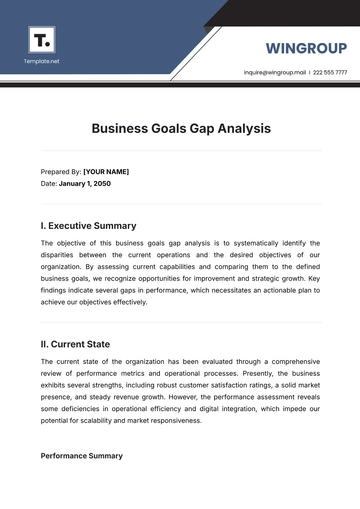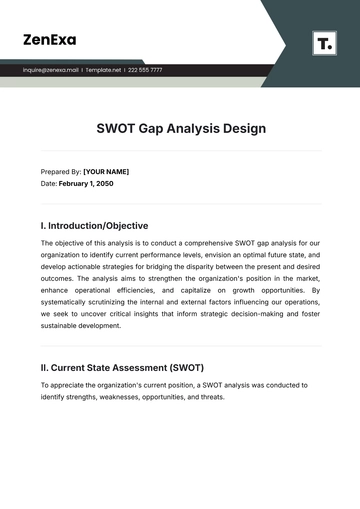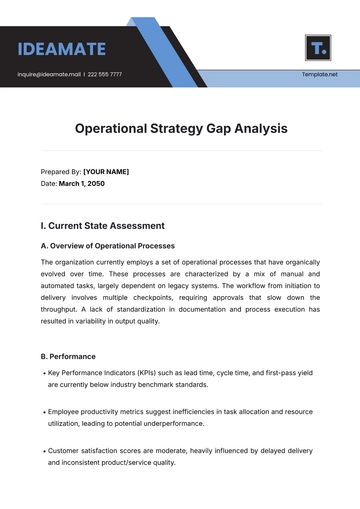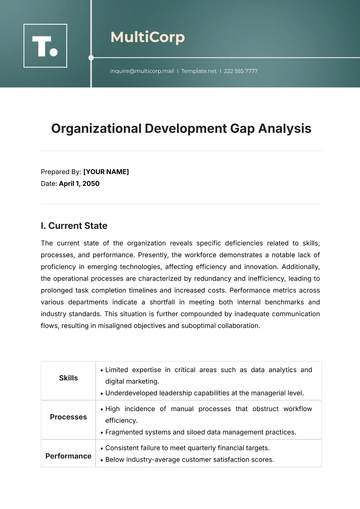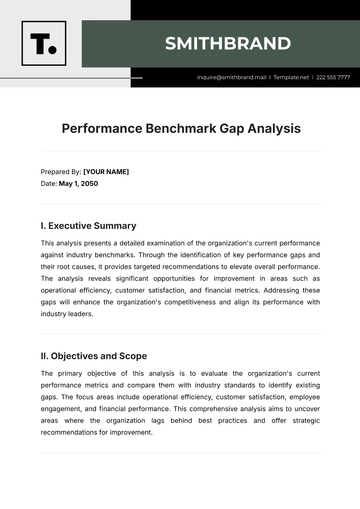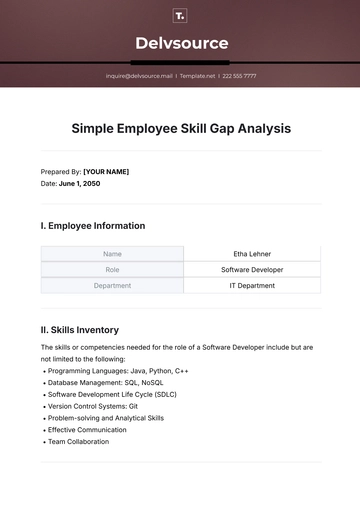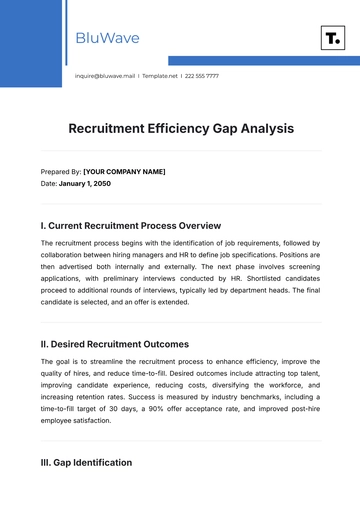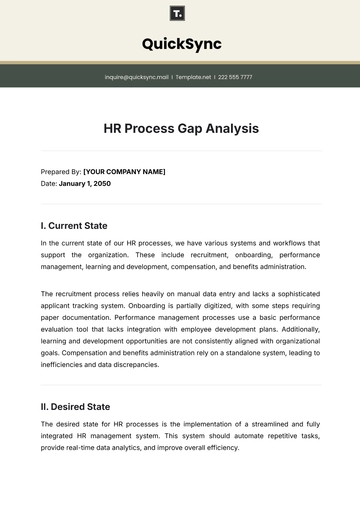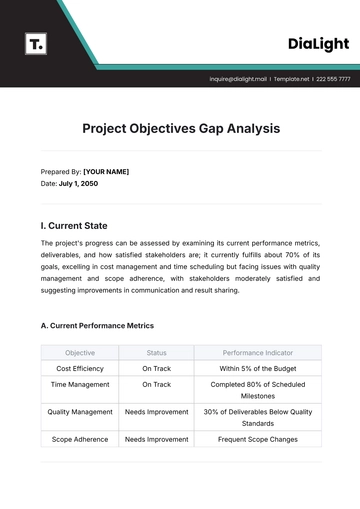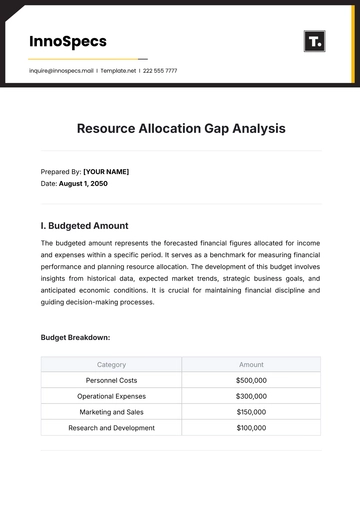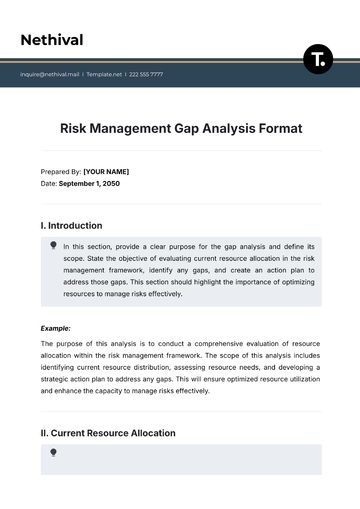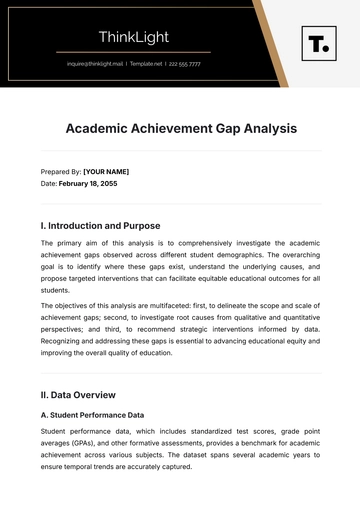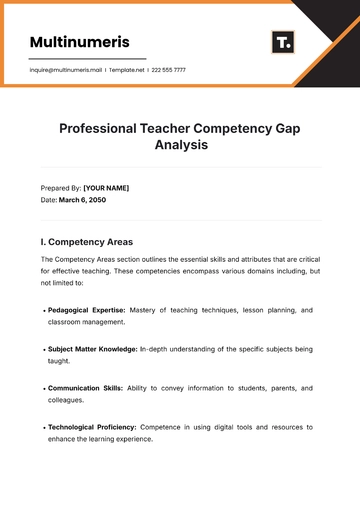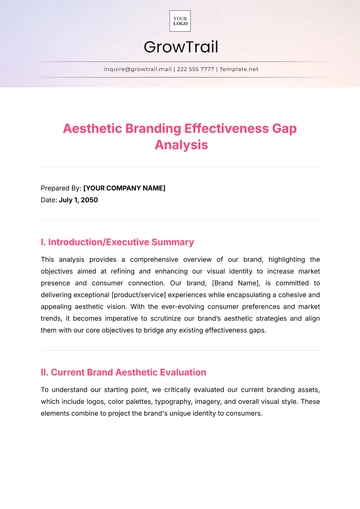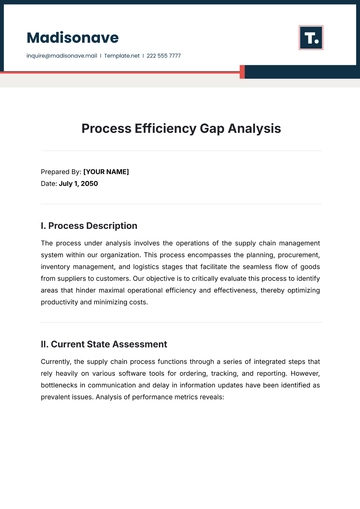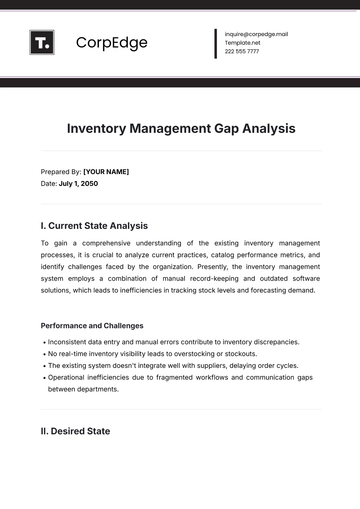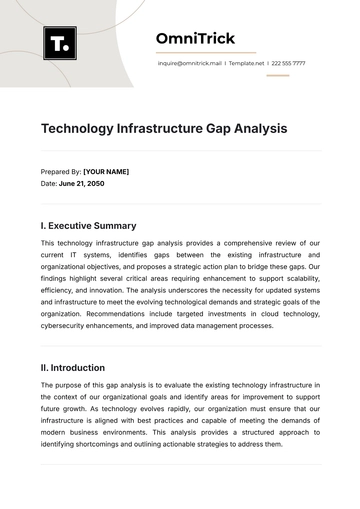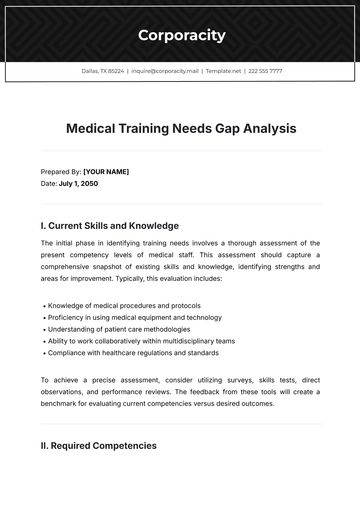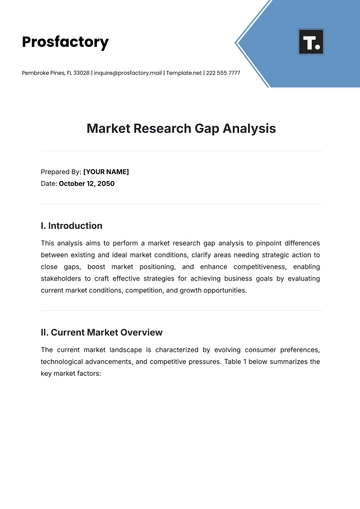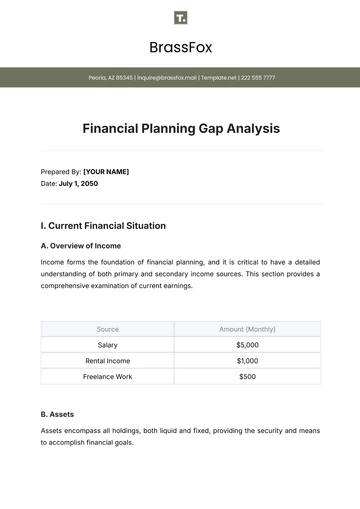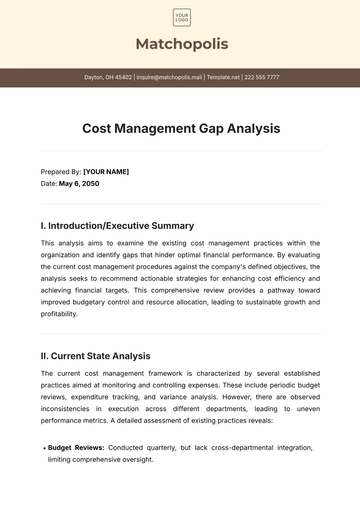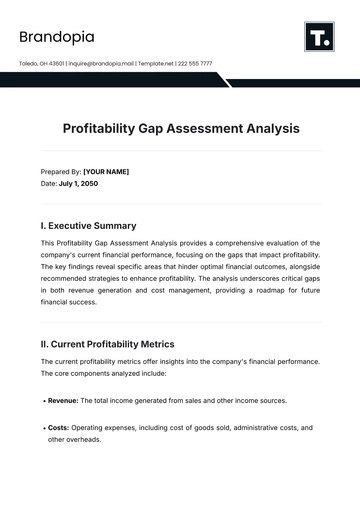Free School Opportunity Analysis
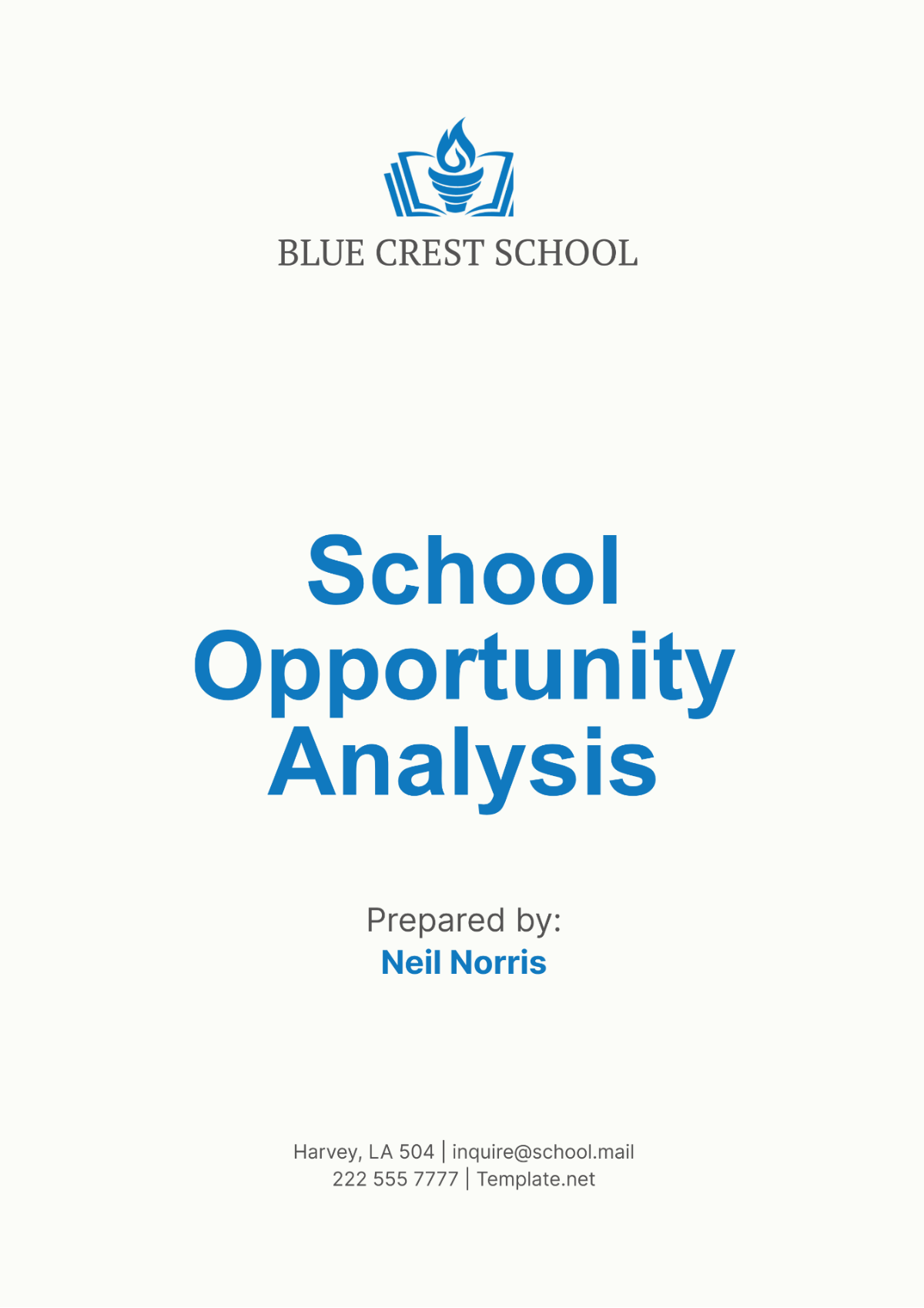
I. Introduction
A. Purpose
Objective: The primary objective of this analysis is to identify and evaluate potential opportunities for growth and improvement at [Your Company Name]. This includes assessing new programs, enhancing existing services, and exploring innovative strategies to enhance the school's overall performance.
Significance: Understanding these opportunities is crucial for strategic planning and ensuring the school remains competitive and continues to provide high-quality education to its students. It enables the school to align its resources effectively and address areas needing improvement.
B. Scope
Areas of Analysis: This analysis covers various aspects of the school’s operations, including academic programs, extracurricular activities, infrastructure, technology integration, and community engagement. Each area will be thoroughly examined to determine its potential for growth and improvement.
Time Frame: The analysis focuses on the current academic year, with projections for the next three to five years to ensure long-term sustainability and growth. This forward-looking approach helps in planning for future needs and challenges.
C. Methodology
Data Collection: Data was collected through surveys, interviews with staff and students, and analysis of academic performance records and financial statements. This comprehensive approach ensures a holistic view of the school’s operations. Multiple data sources provide a well-rounded perspective.
Analytical Methods: Various analytical methods, including SWOT analysis and cost-benefit analysis, were used to evaluate the potential opportunities and their impact on the school’s overall performance. These methods help in identifying strengths, weaknesses, opportunities, and threats systematically.
II. Academic Programs
The following table provides an overview of the current academic programs and their potential for expansion or improvement:
Program | Current Enrollment | Potential Growth | Estimated Cost |
|---|---|---|---|
STEM | 150 | 25% | $50,000 |
Arts & Humanities | 200 | 20% | $30,000 |
Sports | 100 | 30% | $20,000 |
A. STEM
Current Status: The STEM program currently enrolls 150 students, with a potential growth rate of 25%. This indicates a strong interest in science, technology, engineering, and mathematics.
Investment Needs: To support this growth, an estimated investment of $50,000 is required. This will cover new equipment, additional faculty, and enhanced learning materials.
B. Arts & Humanities
Current Status: The Arts & Humanities program enrolls 200 students, with a potential growth rate of 20%. This program is vital for fostering creativity and critical thinking among students.
Investment Needs: An estimated $30,000 is needed to expand this program, including hiring additional staff, updating resources, and organizing events.
C. Sports
Current Status: The Sports program currently has 100 students, with a potential growth rate of 30%. This reflects a high demand for physical education and sports activities.
Investment Needs: To meet this demand, an investment of $20,000 is required. This will fund new sports equipment, facility upgrades, and coaching staff.
Expanding these academic programs can significantly enhance the school's appeal to prospective students and parents. By investing in these areas, [Your Company Name] can offer a more comprehensive and balanced education, which is crucial for the holistic development of students. Enhancing these programs will also help in attracting diverse student populations and improving overall academic performance.
III. Extracurricular Activities
The following table outlines the existing extracurricular activities and their potential for development:
Activity | Current Participation | Potential Growth | Estimated Cost |
|---|---|---|---|
Music | 50 | 40% | $10,000 |
Drama | 30 | 35% | $15,000 |
Robotics | 20 | 50% | $25,000 |
A. Music
Current Status: The Music program currently engages 50 students, with a potential growth rate of 40%. This indicates a strong interest in musical education and performance.
Investment Needs: To support this growth, an estimated investment of $10,000 is required. This will cover new instruments, sheet music, and additional instructors.
B. Drama
Current Status: The Drama club has 30 participants, with a potential growth rate of 35%. This program helps students develop public speaking and acting skills.
Investment Needs: An estimated $15,000 is needed to expand this program, including purchasing costumes, props, and organizing performances.
C. Robotics
Current Status: The Robotics club currently includes 20 students, with a potential growth rate of 50%. This reflects a growing interest in robotics and engineering among students.
Investment Needs: To meet this demand, an investment of $25,000 is required. This will fund new robotics kits, competition fees, and training workshops.
Investing in these extracurricular activities can provide students with valuable skills and experiences beyond the traditional classroom. Enhancing these programs can also improve student engagement and satisfaction, contributing to the overall success of the school. Additionally, these activities help in building a well-rounded student profile, which is essential for college admissions and future career prospects.
IV. Infrastructure Development
The following chart and table highlight the key infrastructure projects and their associated costs and benefits:
Project | Estimated Cost | Expected Benefits |
|---|---|---|
Classroom Renovation | $100,000 | Improved Learning Environment |
New Science Lab | $75,000 | Enhanced STEM Education |
Sports Facility Upgrade | $50,000 | Increased Physical Activity |
A. Classroom Renovation
Current Status: Renovating existing classrooms is essential to provide a modern and conducive learning environment. This project is estimated to cost $100,000.
Expected Benefits: Improved classrooms will enhance student comfort and engagement, leading to better academic performance and satisfaction.
B. New Science Lab
Current Status: Establishing a new science lab is crucial for supporting the growing interest in STEM subjects. This project is estimated to cost $75,000.
Expected Benefits: A state-of-the-art science lab will provide students with hands-on learning experiences, fostering a deeper understanding of scientific concepts.
C. Sports Facility Upgrade
Current Status: Upgrading the sports facilities is necessary to accommodate the increasing participation in sports activities. This project is estimated to cost $50,000.
Expected Benefits: Improved sports facilities will encourage physical activity, teamwork, and overall well-being among students.
Investing in infrastructure development is vital for creating a supportive and effective learning environment. By enhancing these facilities, [Your Company Name] can ensure that students have access to the resources they need to succeed academically and personally. These improvements also help in maintaining the school's competitive edge by offering superior facilities compared to other institutions.
V. Technology Integration
The following table presents the proposed technology integration projects and their potential impact:
Project | Estimated Cost | Expected Benefits |
|---|---|---|
Interactive Whiteboards | $60,000 | Enhanced Interactive Learning |
Student Tablets | $80,000 | Increased Digital Literacy |
Online Learning Platform | $70,000 | Flexible Learning Options |
A. Interactive Whiteboards
Current Status: Introducing interactive whiteboards in classrooms is estimated to cost $60,000. This technology can significantly enhance the teaching and learning experience.
Expected Benefits: Interactive whiteboards will facilitate engaging and interactive lessons, making learning more dynamic and effective.
B. Student Tablets
Current Status: Providing tablets to students is estimated to cost $80,000. This initiative aims to integrate digital tools into everyday learning.
Expected Benefits: Tablets will increase digital literacy among students, preparing them for the technologically advanced world and supporting personalized learning.
C. Online Learning Platform
Current Status: Developing an online learning platform is estimated to cost $70,000. This platform will offer flexible and accessible learning options for students.
Expected Benefits: An online platform will provide students with the ability to access educational resources and courses from anywhere, promoting continuous learning and flexibility.
Integrating advanced technology into the school's operations can significantly enhance the educational experience for students. By investing in these projects, [Your Company Name] can prepare students for the future and ensure they have the skills needed to succeed in a digital world. This integration is crucial for keeping pace with educational advancements and meeting the expectations of modern learners.
VI. Community Engagement
The following chart and table outline the potential community engagement initiatives and their associated costs:
Initiative | Estimated Cost | Expected Benefits |
|---|---|---|
Community Workshops | $20,000 | Strengthened Community Relations |
Parent-Teacher Meetings | $15,000 | Improved Communication |
Volunteer Programs | $10,000 | Enhanced Student Support |
A. Community Workshops
Current Status: Organizing community workshops is estimated to cost $20,000. These workshops aim to involve the community in the school's activities and foster strong relationships.
Expected Benefits: Community workshops will strengthen community relations and support, creating a sense of belonging and collaboration among students, parents, and community members.
B. Parent-Teacher Meetings
Current Status: Enhancing parent-teacher meetings is estimated to cost $15,000. These meetings are crucial for maintaining open communication and addressing student needs.
Expected Benefits: Improved parent-teacher communication will lead to better understanding of student progress and needs, fostering a supportive educational environment.
C. Volunteer Programs
Current Status: Developing volunteer programs is estimated to cost $10,000. These programs encourage community members to contribute to the school's activities.
Expected Benefits: Volunteer programs will enhance student support and provide additional resources for school projects and events.
Effective community engagement is essential for building a supportive and collaborative educational environment. By investing in these initiatives, [Your Company Name] can foster stronger relationships with the community, enhancing the overall educational experience for students. These efforts also help in creating a positive image of the school and attracting more support from stakeholders.
VII. Financial Projections
The following table summarizes the financial projections for the proposed opportunities, including costs, expected revenue increases, and return on investment (ROI):
Opportunity | Cost | Expected Revenue Increase | ROI |
|---|---|---|---|
Academic Programs | $100,000 | $150,000 | 50% |
Extracurricular Activities | $50,000 | $75,000 | 50% |
Infrastructure Development | $225,000 | $300,000 | 33% |
Technology Integration | $210,000 | $280,000 | 33% |
Community Engagement | $45,000 | $60,000 | 33% |
A. Academic Programs
Investment and Returns: Investing $100,000 in academic programs is expected to increase revenue by $150,000. This represents a 50% return on investment (ROI).
Impact: Enhanced academic programs will attract more students, improve academic outcomes, and boost the school's reputation.
B. Extracurricular Activities
Investment and Returns: An investment of $50,000 in extracurricular activities is expected to generate an additional $75,000 in revenue, yielding a 50% ROI.
Impact: Expanded extracurricular activities will enhance student engagement, satisfaction, and overall school appeal.
C. Infrastructure Development
Investment and Returns: Investing $225,000 in infrastructure development is projected to increase revenue by $300,000, resulting in a 33% ROI.
Impact: Improved infrastructure will provide a better learning environment, attract new students, and support academic excellence.
D. Technology Integration
Investment and Returns: An investment of $210,000 in technology integration is expected to generate $280,000 in additional revenue, with a 33% ROI.
Impact: Advanced technology will enhance the learning experience, improve digital literacy, and prepare students for future challenges.
E. Community Engagement
Investment and Returns: Investing $45,000 in community engagement initiatives is expected to increase revenue by $60,000, yielding a 33% ROI.
Impact: Strengthened community relations will foster a supportive educational environment and enhance the school's reputation.
The financial projections indicate that the proposed opportunities are financially viable and can significantly enhance the school's overall performance. By strategically investing in these areas, [Your Company Name] can achieve sustainable growth and success. Each of these initiatives not only promises substantial financial returns but also contributes to the holistic development of students, making the school a preferred choice for parents and students alike.
VIII. Risk Analysis
The following table outlines the potential risks associated with the proposed opportunities and their mitigation strategies:
Risk | Impact | Mitigation Strategy |
|---|---|---|
Budget Overruns | High | Implement strict budget controls |
Low Enrollment | Medium | Enhance marketing efforts |
Technological Challenges | High | Provide training and support |
Community Resistance | Medium | Increase engagement and communication |
A. Budget Overruns
Impact: Budget overruns can significantly impact the school's financial stability and delay project completion. These overruns can strain resources and affect the implementation of other critical projects.
Mitigation Strategy: Implementing strict budget controls and regular financial reviews will help manage costs and prevent overruns. This includes setting realistic budgets, monitoring expenditures closely, and adjusting plans as needed.
B. Low Enrollment
Impact: Low enrollment can affect revenue and the success of new programs. It can lead to underutilization of resources and affect the overall viability of the school's growth plans.
Mitigation Strategy: Enhancing marketing efforts and showcasing the benefits of the new opportunities can attract more students. This includes targeted advertising, open houses, and engaging with the community to highlight the school's strengths.
C. Technological Challenges
Impact: Technological challenges can hinder the successful implementation of technology integration projects. These challenges can include technical issues, resistance to change, and inadequate training.
Mitigation Strategy: Providing training and support for staff and students will ensure smooth adoption of new technologies. This includes workshops, continuous technical support, and creating a culture that embraces technological advancements.
D. Community Resistance
Impact: Community resistance can affect the success of community engagement initiatives. It can lead to opposition, reduced participation, and a lack of support for the school's programs.
Mitigation Strategy: Increasing engagement and communication with the community can build support and reduce resistance. This involves regular updates, involving community members in decision-making processes, and addressing their concerns effectively.
Addressing these risks is crucial for the successful implementation of the proposed opportunities. By proactively managing these risks, [Your Company Name] can ensure smooth execution and achieve the desired outcomes. Effective risk management will help in maintaining the school's stability and fostering a positive environment for growth.
IX. Conclusion
The Opportunity Analysis of [Your Company Name] identifies several potential opportunities for growth and improvement. By strategically investing in academic programs, extracurricular activities, infrastructure development, technology integration, and community engagement, the school can enhance its overall performance and achieve sustainable success.
Careful management of associated risks and implementation of effective mitigation strategies are essential to ensure the successful execution of these opportunities. Through these efforts, [Your Company Name] can continue to provide high-quality education and create a positive impact on students and the community. By prioritizing these areas, the school can maintain its competitive edge and fulfill its mission of delivering exceptional education.
- 100% Customizable, free editor
- Access 1 Million+ Templates, photo’s & graphics
- Download or share as a template
- Click and replace photos, graphics, text, backgrounds
- Resize, crop, AI write & more
- Access advanced editor
Analyze with ease with the School Opportunity Analysis Template! Available on Template.net, this template is customizable to suit various analysis needs. Its editable format allows for easy modifications and updates. Leverage the AI Editor Tool to create detailed opportunity analysis, helping your school make informed decisions! Get your access now!

